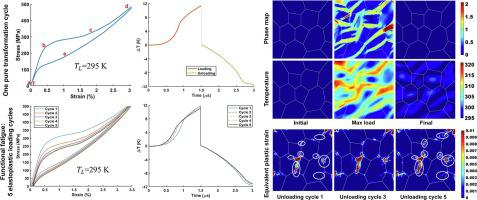当前位置:
X-MOL 学术
›
Comp. Mater. Sci.
›
论文详情
Our official English website, www.x-mol.net, welcomes your
feedback! (Note: you will need to create a separate account there.)
On the elastocaloric effect in CuAlBe shape memory alloys: A quantitative phase-field modeling approach
Computational Materials Science ( IF 3.1 ) Pub Date : 2020-10-01 , DOI: 10.1016/j.commatsci.2020.109808 Cheikh Cissé , Mohsen Asle Zaeem
Computational Materials Science ( IF 3.1 ) Pub Date : 2020-10-01 , DOI: 10.1016/j.commatsci.2020.109808 Cheikh Cissé , Mohsen Asle Zaeem

|
Abstract The reversible stress-induced phase transformation in shape memory alloys (SMAs) is a dissipative process during which heat is absorbed or released. The inherent temperature variations inside the material has an elastocaloric effect (eCE) with appealing applications in solid-state cooling technology such as compact and efficient on-board refrigeration system for eletronic devices. In this manuscript, we conduct the first study of eCE of CuAlBe SMAs utilizing phase-field modeling. For an applied stress of 500 MPa, the results for polycrystalline Cu-Al11-2Be (at. %) show a minimum adiabatic unloading temperature change of −10 K over a pseudoelastic window of 40 K. In the absence of plastic deformation, the material demonstrates good reproducibility of the eCE over a few loading–unloading cycles. The presence of plastic deformation is found to cause functional fatigue that deteriorates the cooling capacity; however, the coefficient of performance only decreases from 9.04 to 8.03, which is still a very good value. These results place CuAlBe as a frontrunner SMA for solid-state cooling compared to the expensive NiTi.
中文翻译:

关于 CuAlBe 形状记忆合金的弹性热效应:一种定量相场建模方法
摘要 形状记忆合金 (SMA) 中的可逆应力诱导相变是一个耗散过程,在此过程中热量被吸收或释放。材料内部的固有温度变化具有弹性热效应 (eCE),在固态冷却技术中具有吸引人的应用,例如用于电子设备的紧凑高效的机载制冷系统。在这份手稿中,我们利用相场建模对 CuAlBe SMA 的 eCE 进行了首次研究。对于 500 MPa 的外加应力,多晶 Cu-Al11-2Be (at. %) 的结果显示,在 40 K 的伪弹性窗口上,最小绝热卸载温度变化为 -10 K。在没有塑性变形的情况下,材料在几次加载-卸载循环中证明了 eCE 的良好重现性。发现塑性变形的存在会引起功能性疲劳,使冷却能力变差;但是,性能系数仅从 9.04 下降到 8.03,这仍然是一个非常好的值。与昂贵的 NiTi 相比,这些结果使 CuAlBe 成为固态冷却的领跑者 SMA。
更新日期:2020-10-01
中文翻译:

关于 CuAlBe 形状记忆合金的弹性热效应:一种定量相场建模方法
摘要 形状记忆合金 (SMA) 中的可逆应力诱导相变是一个耗散过程,在此过程中热量被吸收或释放。材料内部的固有温度变化具有弹性热效应 (eCE),在固态冷却技术中具有吸引人的应用,例如用于电子设备的紧凑高效的机载制冷系统。在这份手稿中,我们利用相场建模对 CuAlBe SMA 的 eCE 进行了首次研究。对于 500 MPa 的外加应力,多晶 Cu-Al11-2Be (at. %) 的结果显示,在 40 K 的伪弹性窗口上,最小绝热卸载温度变化为 -10 K。在没有塑性变形的情况下,材料在几次加载-卸载循环中证明了 eCE 的良好重现性。发现塑性变形的存在会引起功能性疲劳,使冷却能力变差;但是,性能系数仅从 9.04 下降到 8.03,这仍然是一个非常好的值。与昂贵的 NiTi 相比,这些结果使 CuAlBe 成为固态冷却的领跑者 SMA。











































 京公网安备 11010802027423号
京公网安备 11010802027423号